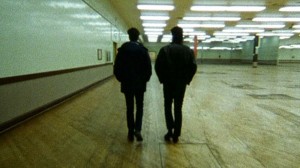Yet another great of 20th C. cinema leaves this world. Some fitting tributes can be found on The Guardian site here .
Monthly Archives: July 2007
Getting outside yourself
“Every moment in our life presents the two aspects, it is actual and virtual perception on the one side and recollection on the other…Whoever becomes conscious of the continual duplicating of his present into perception and recollection will compare himself to an actor playing his part automatically, listening to himself and beholding himself playing.”
Henri Bergson, Matter and Memory as quoted by Gilles Deleuze in Cinema 2 P.79
Alog: Amateur

In the words of much loved Sydney late 70s/early 80s outfit The Particles, Lets bang bits of wood together:
I picked this up the other day (after an small search in the woefully organised and stocked Bastille FNAC) and must say I am intrigued. The latest from Norwegian duo Alog on the ever engaging Rune Grammofon label is their most perplexing and (perhaps) rewarding work to date. While their previous releases have been marked by an ever increasing concern with using organic sound sources in the digital environment Amateur sees them taking this to a whole new level. Human, voice, bells, creaking doors and as evidenced by the photo on the CD sleeve nails in blocks of wood all jostle for prominence in the sound space. Overlaps and juxtapositions of sound create rhythms and textures that put me in mind of later period Matmos which can only be good thing. Check out the video of the lead track “Son of King” on the Alog website.
The Image to Come
I finally got the chance to see Alan Clarke’s 1988 made-for-TV film Elephant. It is a little seen work that is now most famous for providing the inspiration (and title) for Gus Van Sant’s haunting meditation on the Columbine massacre. Clark’s Elephant was included in the exhibition L’image D’aprés at the Cinémathéque Française. The Exhibition itself was an ambitious curatorial undertaking that sought to uncover “how cinema inspires photographers” or more precisely, a selection of Magnum agency photographers. 10 Magnum shooters were asked to nominate a film, filmmaker, or in some cases body of films that had influenced their visual and philosophical approach. These photographers were exhibited in the gallery space in relation to the chosen film works. As to be expected the results were somewhat varied both in terms of visual and conceptual resonance. The more successful pairings, as in the case of Gueorgui Pinkhassoh’s touching elegy to Andrei Tarkovski and Mark Power’s installation, operated through a strategy that foregrounded the “personal” as a way through the implied resoluteness of the photographic medium. Mark Power’s work used Krzysztof Kieslowski’s 1979 “Camera Buff” as a cypher of sorts through which to consider his own blurred photographs and the super-8 artefacts of his youth. These family films were shown at the bottom of a specially constructed tank, the images literally submerged like so many memories.
Selected by photographer Donovan Wylie, Alan Clarke’s film Elephant formed a type of exclamation mark to a deeply personal exploration of the political situation in Northern Ireland of 1970s and 80s. Using an ensemble of materials that ranged through scrapbook cuttings (his great uncle’s), photographs, film loops and stills, and assorted ephemera Wylie alluded to the very specific conditions of that time and place. A time and place, that in Wylie’s own words, facilitated “…a great tension between the private and the collective, the personal and the political, the normal life and the abnormal life..” It is this slippage between the “normal life and the abnormal life” that also powers Alan Clarke’s film Elephant, albeit in a much more detached and focused manner
Commissioned in 1988 by BBC Northern Ireland the 39 minute film presents 18 sectarian murders in succession with no other narrative support. Each murder is presented using the same formal strategy: a single steady-cam shot doggedly follows a lone figure through the endlessly bleak urban landscape. A journey that invariable climaxes in the figure drawing a gun and shooting a usually surprised, sometimes desperately scared victim. After which reigns silence, as the now static camera lingers on the lifeless body of the victim. Seen singularly each murder is all the more chilling for the matter of fact way in which it is portrayed. The camera’s viewpoint is at once detached and involving as we hover over the killers shoulder through the often circuitous journey to the “event”. But it is only when the murders are viewed collectively that the real weight of this work can be felt. With each more murder a powerful sense of inevitability pervades. There is no rational hope that anyone escapes their fate, put simply, this is not that kind of film. Within the exhibition installation the film is shown as a loop in small dedicated screening space, a format that further reinforces a sense of the endless inevitability of violence. One can only imagine how this film would have originally appeared on television being as it is a medium not renowned for its promotion of such audacious conceptual or formal statements.
Introducing…
Welcome, contained herein you will find musings by Ryszard Dabek on a range of topics related to although not necessarily bound by art, sound and architecture. In particular this space will be used to record impressions and research related to my travels and residence in Paris and Warsaw during July to October 2007.

